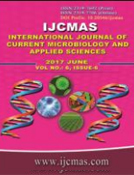


 National Academy of Agricultural Sciences (NAAS)
National Academy of Agricultural Sciences (NAAS)

|
PRINT ISSN : 2319-7692
Online ISSN : 2319-7706 Issues : 12 per year Publisher : Excellent Publishers Email : editorijcmas@gmail.com / submit@ijcmas.com Editor-in-chief: Dr.M.Prakash Index Copernicus ICV 2018: 95.39 NAAS RATING 2020: 5.38 |
Narrow genetic base is one of the most important limiting factors for yield improvement and is a bottleneck in any of the breeding programs. Information on genetic diversity and heterotic groups is very useful in inbred line development and help breeders to utilize their germplasm in a more efficient and consistent manner through exploitation of complementary lines for maximizing the outcomes of a hybrid breeding program. Development of hybrid oriented heterotic populations and application of schemes for improving combining ability is an integral part of hybrid breeding in maize and other cross pollinated crops. Broadening the genetic base of heterotic pools is a key to ensure continued genetic gain in hybrid breeding. The selection of parents and breeding strategies for the successful hybrid production will be facilitated by heterotic grouping of parental lines and determination of combining abilities of them. Assigning germplasms into different heterotic groups and patterns is fundamental for exploitation of heterosis for hybrid development. If once heterotic groups and their pattern are identified then large number of hybrid combination can be developed, within short period of time because grouping of lines in different clusters would avoid the development and evaluation of unnecessary hybrids from these heterotic patterns. Our objectives of this review are (i) Review various methods used to assign germplasm into heterotic groups and identify their heterotic pattern in different crops on the basis of experimental evidence supporting them. (ii) Listing out various heterotic groups and heterotic patterns in different crops and (iii) Examine advantages and disadvantages of the concept of heterotic groups and patterns.
 |
 |
 |
 |
 |